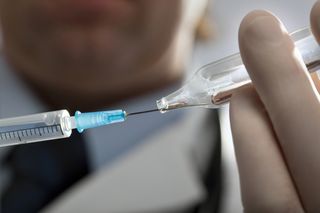Smallpox-Like Virus Infects Lab Worker After Mishap

A lab worker in Boston became infected with a virus similar to smallpox after he accidentally stuck himself with a needle that was contaminated with the virus, according to a new report of the case.
But the case is noteworthy because the worker developed the infection despite having recently been vaccinated against the virus, which was intended to protect him in case of exactly such an accident.
In November 2013, the 27-year-old lab worker was preforming an experiment that required him to inject mice with the vaccinia virus — which is the virus in the smallpox vaccine. (The vaccinia virus is similar to smallpox, but doesn't actually cause the disease.) While putting a cap back on the needle he was using, he accidentally stuck the needle into his left thumb.
The worker immediately sterilized his gloves and washed his hands for 10 minutes, and saw that there was a small amount of blood from his injury. He filed an accident report at his work, and was told to go to the emergency room if he had signs of infection.
About a week later, the man developed a rash on his left bicep, and went to the ER. But the hospital doctors thought the man had a bacterial infection, and gave him antibiotics.
A few days later, the man developed a lesion of dead tissue on his thumb, and went to a health clinic at his work, where he was diagnosed with a vaccinia virus infection.
But soon, the man began to recover and the rash on his arm started to go away. About two weeks later, the man had the dead tissue removed from the wound on his thumb, and a sample from the wound tested positive for vaccinia virus. Over the next month, his skin lesion disappeared, and he no longer had symptoms, according to the report, from the Centers for Disease Control and Prevention. [7 Devastating Infectious Diseases]
Sign up for the Live Science daily newsletter now
Get the world’s most fascinating discoveries delivered straight to your inbox.
About 10 months before his injury, the man had received the smallpox vaccine because his job required him to work with the vaccinia virus. At that time, the man appeared to have a proper reaction to the vaccine — he developed a small white lesion at the vaccination site — which is thought to indicate a successful immune response to the vaccine. (The general public is no longer vaccinated against smallpox, since the disease has been eradicated worldwide.)
The man appears to be the first person to develop a vaccinia virus infection from a lab accident, even though he was recently vaccinated against the disease, the researchers said. It's not clear why the man developed an infection despite being vaccinated, but the researchers noted that the level of immune response needed to protect against the vaccinia virus is not known.
It's possible that the smallpox vaccine didn't fully protect the man against infection, but that it reduced the severity of his symptoms, the researchers said.
"This underscores the importance of smallpox vaccination among laboratory workers who use [vaccinia virus] in research settings," the researchers said.
In addition, "establishing and reinforcing safe laboratory practices such as proper handling of contaminated needles and use of personal protective equipment is important in reducing the risk of injury and infection," the researchers said.
The man had received proper safety training, and an investigation of the lab showed that it was well maintained, the report said. But after the incident the laboratory discouraged the practice of recapping needles.
The case was reported this week in the CDC journal Morbidity and Mortality Weekly Report.
Follow Rachael Rettner @RachaelRettner. Follow Live Science @livescience, Facebook & Google+. Original article on Live Science.

Rachael is a Live Science contributor, and was a former channel editor and senior writer for Live Science between 2010 and 2022. She has a master's degree in journalism from New York University's Science, Health and Environmental Reporting Program. She also holds a B.S. in molecular biology and an M.S. in biology from the University of California, San Diego. Her work has appeared in Scienceline, The Washington Post and Scientific American.
